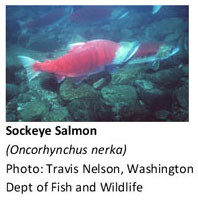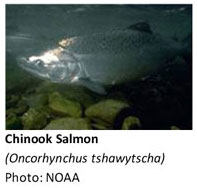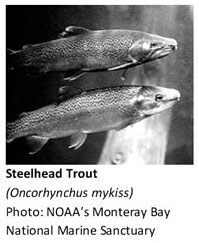There are four Endangered Species Act listed salmonids within Nez Perce County. Each are described below. Descriptions and photographs were obtained from the NOAA National Marine Fisheries Service website.

Sockeye Salmon(Oncorhynchus nerka)
Listed Endangered – NOAA Fisheris Jurisdiction
The adult spawners are unique in appearance. They typically turn bright red, with a green head; hence they are commonly called "red" salmon in Alaska. During the ocean and adult migratory phase, sockeye often have a bluish back and silver sides, giving rise to another common name, "bluebacks."
The name "sockeye" is thought to have been a corruption of the various Indian tribes' word "sukkai."
Adults migrate from a marine environment into freshwater streams and rivers or lakes of their birth in order to mate (called anadromy). They spawn only once and then die (called semelparity). Sockeye salmon exhibit a wide variety of life history patterns that reflect varying dependency on the freshwater environment. With the exception of certain river-type and sea-type populations, the vast majority of sockeye salmon spawn in or near lakes, where the juveniles rear for 1 to 3 years prior to migrating to sea. For this reason, the major distribution and abundance of large sockeye salmon stocks are closely related to the location of rivers that have accessible lakes in their watersheds for juvenile rearing. For more information check out the NOAA website.

Spring/Summer Chinook Salmon (Oncorhynchus tschawytscha)
Fall Chinook (Oncorhynchus tschawytscha)
Listed Threatened – NOAA Fisheries jurisdiction
Adults migrate from a marine environment into the freshwater streams and rivers of their birth in order to mate (called anadromy). They spawn only once and then die (called semelparity).
Juvenile Chinook may spend from 3 months to 2 years in freshwater before migrating to estuarine areas as smolts and then into the ocean to feed and mature. Chinook salmon remain at sea for 1 to 6 years (more commonly 2 to 4 years), with the exception of a small proportion of yearling males (called jack salmon) which mature in freshwater or return after 2 or 3 months in salt water.
There are different seasonal (i.e., spring, summer, fall, or winter) "runs" in the migration of Chinook salmon from the ocean to freshwater, even within a single river system. These runs have been identified on the basis of when adult Chinook salmon enter freshwater to begin their spawning migration. However, distinct runs also differ in the degree of maturation at the time of river entry, the temperature and flow characteristics of their spawning site, and their actual time of spawning. Freshwater entry and spawning timing are believed to be related to local temperature and water flow regimes. For additional information check out the NOAA website.

Steelhead (Oncorhyncus mykiss)
Listed Threatened - NOAA Fisheries Jurisdiction
They are a unique species; individuals develop differently depending on their environment. While all O. mykiss hatch in gravel-bottomed, fast-flowing, well-oxygenated rivers and streams, some stay in fresh water all their lives. These fish are called rainbow trout. The steelhead that migrate to the ocean develop a slimmer profile, become more silvery in color, and typically grow much larger than the rainbow trout that remain in fresh water.
Adults migrate from a marine environment into the freshwater streams and rivers of their birth in order to mate (called anadromy). Unlike other Pacific salmonids, they can spawn more than one time (called iteroparity). Migrations can be hundreds of miles.
Young animals feed primarily on zooplankton. Adults feed on aquatic and terrestrial insects, mollusks, crustaceans, fish eggs, minnows, and other small fishes (including other trout).
Maximum age is about 11 years. Males mature generally at 2 years and females at 3 years. Juvenile steelhead may spend up to 7 years in freshwater before migrating to estuarine areas as smolts and then into the ocean to feed and mature. They can then remain at sea for up to 3 years before returning to freshwater to spawn. Some populations actually return to freshwater after their first season in the ocean, but do not spawn, and then return to the sea after one winter season in freshwater. Timing of return to the ocean can vary, and even within a stream system there can be different seasonal runs. For additional information check out the NOAA website.